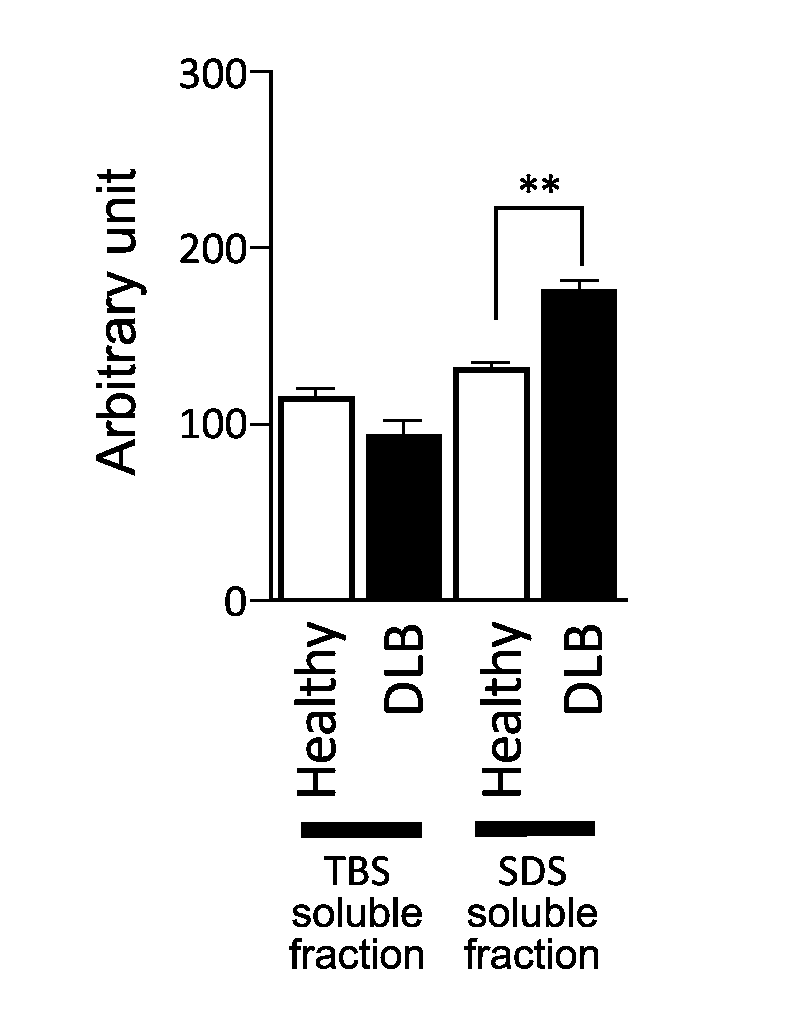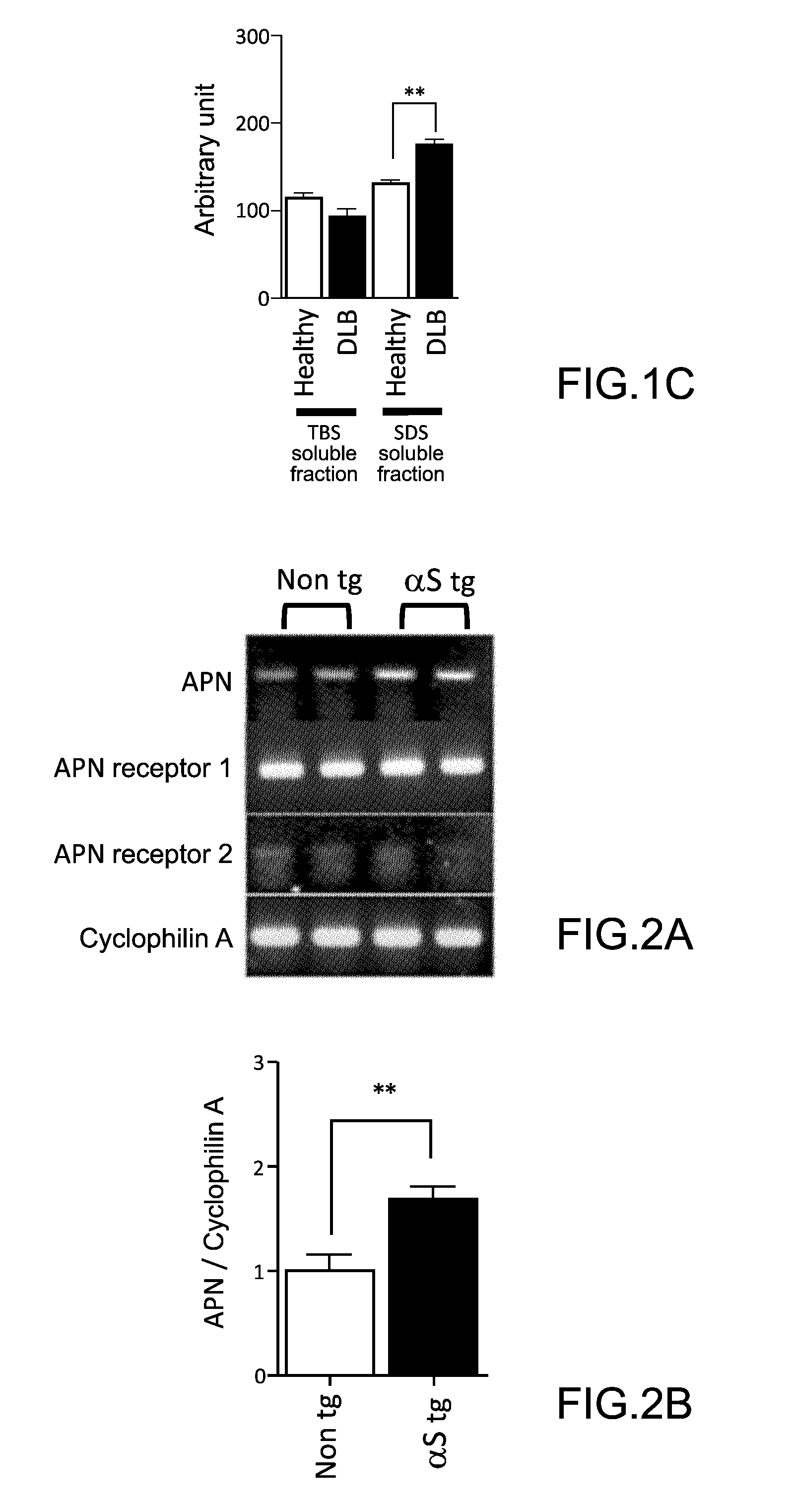Method for treating and/or preventing neurodegenerative disease by adiponectin receptor agonist
a technology of adiponectin receptor and adiponectin, which is applied in the field of treating and/or preventing neurodegenerative diseases including synucleinopathy, can solve the problems of abnormal accumulation of amyloid- (beta)-protein and tau, abnormal accumulation of tau, and collapse of normal cytoskeleton, so as to reduce the effect of suppressing (alpha)-synuclein aggregation, tau phosphorylation, and the effect of phospho
- Summary
- Abstract
- Description
- Claims
- Application Information
AI Technical Summary
Benefits of technology
Problems solved by technology
Method used
Image
Examples
experimental example 1
Expression and Location of Adiponectin in Human Brain
1. Material and Method
[0117]1.1 Antibody
[0118]An anti-adiponectin C-terminus recognizing rabbit polyclonal antibody (Novus Biologicals, LLC), an anti-adiponectin N-terminus recognizing rabbit polyclonal antibody (Abcam plc.), an anti-adiponectin receptor 1 (AdipoR1) goat polyclonal antibody (Santa Cruz Biotechnology, Inc), an anti-α (alpha)-synuclein mouse monoclonal antibody (syn-1, Nippon Becton Dickinson Company, Ltd), an anti-phosphorylated α (alpha)-synuclein mouse monoclonal antibody (Wako Pure Chemical Industries, Ltd.) and an anti-β (beta)-actin mouse monoclonal antibody (C-15, Sigma-Aldrich Japan Inc.) were used as primary antibodies after being appropriately diluted.
[0119]With regard to fluorescence immunohistochemical staining, an Alexa Fluor 488 labeled anti-rabbit antibody and an Alexa Fluor 594 labeled anti-mouse antibody (Invitrogen, Life Technologies Japan Ltd.) were used as secondary antibodies after being appropr...
experimental example 2
Adiponectin Expression in Thy-1-α (Alpha)S Transgenic Mouse Brain-Specifically Expressing α (Alpha)-Synuclein
1. Material and Method
[0131]1.1 Transgenic Animal
[0132]Thy-1-α (alpha)S transgenic mice neuron-specifically express human α (alpha)-synuclein gene by a Thy-1 promoter (referred to as an α (alpha)S tg mice hereunder: University of California, San Diego, donated by Prof. Eliezer Masliah, Rockenstein et al., J. Neurosci. Res. 66:573(2002)). The α (alpha)S tg mice were reared and bred in an SPF animal room in Tokyo Metropolitan Institute of Medical Science. The α (alpha)S tg mice were crossbred with C57BL / 6 (CLEA Japan, Inc.). Here, genetic screening was performed using PCR method. While mice having transgene were categorized as an experimental group, wild-type littermate mice (referred to as non tg mice hereunder) were categorized as a control group. Male α (alpha)S tg mice and non tg mice aged seven months were anesthetized, and then had blood thereof removed by perfusion with ...
experimental example 3
Adiponectin Expression in Cultured Neuron Expressing α (Alpha)-Synuclein
1. Material and Method
[0143]1.1 Cell Culture
[0144]Under a condition of 5% CO2 and 37° C., rat B103 neuroblastoma cells were cultured and then subcultured in a high-glucose Dulbecco's modified Eagle's medium (referred to as “DMEM” hereunder. GIBCO, Invitrogen, Life Technologies Japan Ltd.), the DMEM containing 10% fetal bovine serum (FBS, BioWest, Funakoshi Co., Ltd.) and 1% v / v penicillin / streptomycin (catalog number: 15070-063, Invitrogen, Life Technologies Japan Ltd.).
[0145]1.2 Preparation of B103 Rat Neuroblastoma Cells Artificially Expressing α (Alpha)-Synuclein
[0146]A construct of pCEP4-α (alpha)-synuclein prepared by Takenouchi et al. (Takenouchi et al., Mol. Cell. Neurosci., 17:141(2001)) was used to constantly express α (alpha)-synuclein cDNA. B103 neuroblastoma cells transfected with the construct of pCEP4-α (alpha)-synuclein (referred to hereunder as B103 neuroblastoma cells (α (alpha)S) were prepared ...
PUM
 Login to View More
Login to View More Abstract
Description
Claims
Application Information
 Login to View More
Login to View More - R&D
- Intellectual Property
- Life Sciences
- Materials
- Tech Scout
- Unparalleled Data Quality
- Higher Quality Content
- 60% Fewer Hallucinations
Browse by: Latest US Patents, China's latest patents, Technical Efficacy Thesaurus, Application Domain, Technology Topic, Popular Technical Reports.
© 2025 PatSnap. All rights reserved.Legal|Privacy policy|Modern Slavery Act Transparency Statement|Sitemap|About US| Contact US: help@patsnap.com



